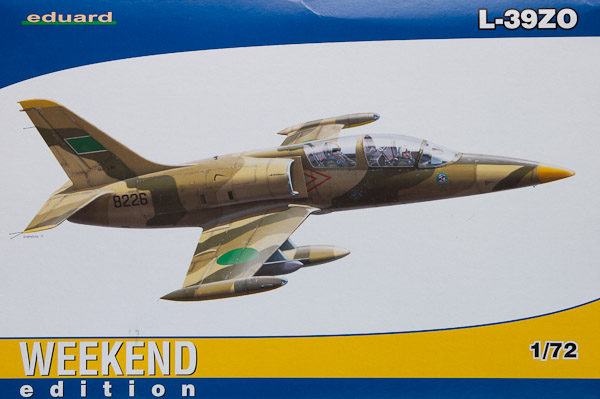
Eduard 1/72 L-39ZO Weekend Edition
By Chris Banyai-Riepl
Overview
The Aero L-39 Albatros is the most widely used jet trainer in the world today, a rather impressive record for a plane designed in the early 1960s. The L-39 was also the first turbofan-powered trainer, and it can be found in the air forces of over 30 nations worldwide. It is also quite popular among civilian pilots, with quite a few seen on the air show circuit. A search at some of the popular aviation photo sites such as jetphotos.net or airliners.net will result in quite a few photos of these diminutive jets, offering up some excellent reference material and exhibiting the wide range of color schemes the L-39 wears.
The Kit
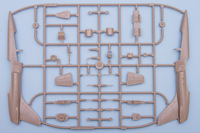 Eduard's well-known kit of the L-39 Albatros comes molded in tan plastic and features nicely recessed panel lines and simple construction, but plenty of detail. As this is a Weekend Edition release, it is a bit simpler than the other releases from Eduard. Most notably absent from this release is the photoetch details, a common sacrifice in the Weekend Edition kits. The decal sheet also provides markings for a single option.
Eduard's well-known kit of the L-39 Albatros comes molded in tan plastic and features nicely recessed panel lines and simple construction, but plenty of detail. As this is a Weekend Edition release, it is a bit simpler than the other releases from Eduard. Most notably absent from this release is the photoetch details, a common sacrifice in the Weekend Edition kits. The decal sheet also provides markings for a single option.
So, recognizing the omissions, let’s take a look at what you get. While the full kit includes comprehensive photoetch for the cockpit, this one simplifies things greatly, utilizing decals for the instrument panels and side consoles. There are separate rudder pedals, control columns, center bulkhead, and instrument panel hoods. The seats are made up from five pieces and look halfway decent straight out of the box. No belts are provided, and the addition of some tape or foil belts will make a huge improvement here.
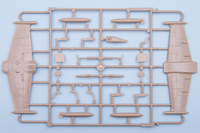 The finished tub fits nicely into the fuselage, and along with an engine face and an exhaust piece, the fuselage can be closed up. There is no mention of nose weight in the instructions, but you might want to drop a bit in there, just in case. There is not much room in front of the cockpit, but there is behind the rear bulkhead, and it is likely that not much will be needed anyway. With the fuselage together, all that’s left for that assembly is to put the air intakes on, which have separate splitter plates, and add the stabilizers.
The finished tub fits nicely into the fuselage, and along with an engine face and an exhaust piece, the fuselage can be closed up. There is no mention of nose weight in the instructions, but you might want to drop a bit in there, just in case. There is not much room in front of the cockpit, but there is behind the rear bulkhead, and it is likely that not much will be needed anyway. With the fuselage together, all that’s left for that assembly is to put the air intakes on, which have separate splitter plates, and add the stabilizers.
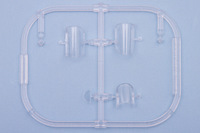 For the wings, they come in two pieces, a full-span top and bottom piece. This incorporates a large section of the lower fuselage as well, which will make assembly simple. Take care, though, to make sure that the wing is positioned properly, as it would be all too easy to get the alignment slightly off and end up with the finished model looking lopsided. For underneath, the kit comes with two drop tanks and two rockets for underwing stores. The landing gear is simple, much like the real thing. Do note that the gear doors are molded closed, which is correct for the L-39. Those doors only open when the gear is extending or retracting. Some additional antennae and the canopy are all that’s left before it is time to throw paint down on this kit.
For the wings, they come in two pieces, a full-span top and bottom piece. This incorporates a large section of the lower fuselage as well, which will make assembly simple. Take care, though, to make sure that the wing is positioned properly, as it would be all too easy to get the alignment slightly off and end up with the finished model looking lopsided. For underneath, the kit comes with two drop tanks and two rockets for underwing stores. The landing gear is simple, much like the real thing. Do note that the gear doors are molded closed, which is correct for the L-39. Those doors only open when the gear is extending or retracting. Some additional antennae and the canopy are all that’s left before it is time to throw paint down on this kit.
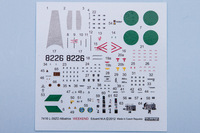 The decal choice in this kit is for a Libyan example from 1985, coded 8226 in black on the fuselage. This plane is camouflaged in sand yellow, tan, and green over light gray. The Libyan markings are very simple, consisting of green circles for the wings and a green swept flag on the tail. The decal sheet provides quite a bit in the way of stenciling, though, so you will have lots of little decals to apply. These will add quite a bit of visual appeal to the final model, though, so the time spent applying these will be well worth it. The decals are nicely printed and should present no problems in application.
The decal choice in this kit is for a Libyan example from 1985, coded 8226 in black on the fuselage. This plane is camouflaged in sand yellow, tan, and green over light gray. The Libyan markings are very simple, consisting of green circles for the wings and a green swept flag on the tail. The decal sheet provides quite a bit in the way of stenciling, though, so you will have lots of little decals to apply. These will add quite a bit of visual appeal to the final model, though, so the time spent applying these will be well worth it. The decals are nicely printed and should present no problems in application.
Conclusion
This is an excellent kit of an attractive aircraft, even without all the extras found in the full kit. My thanks to Eduard for the review sample.
